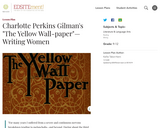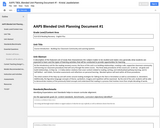
This unit walks students through a variety of activities revolving around George Orwell's book '1984'.
- Subject:
- English Language Arts
- Material Type:
- Unit of Study
- Provider:
- Michigan Virtual
- Author:
- Abby Perdok
- Date Added:
- 06/28/2017

This unit walks students through a variety of activities revolving around George Orwell's book '1984'.

This collection uses primary sources to explore The Absolutely True Diary of a Part-Time Indian by Sherman Alexie. Digital Public Library of America Primary Source Sets are designed to help students develop their critical thinking skills and draw diverse material from libraries, archives, and museums across the United States. Each set includes an overview, ten to fifteen primary sources, links to related resources, and a teaching guide. These sets were created and reviewed by the teachers on the DPLA's Education Advisory Committee.

The Folger Shakespeare Library provides the full searchable text of "As You Like It" to read online or download as a PDF. All of the lines are numbered sequentially to make it easier and more convenient to find any line.

In this lesson, students will analyze archetypes and how they contribute to universal story telling and character development.

The Folger Shakespeare Library provides the full searchable text of "All's Well That Ends Well" to read online or download as a PDF. All of the lines are numbered sequentially to make it easier and more convenient to find any line.

In this lesson, students will explore these questions, comparing Lana Del Rey's "Young and Beautiful" with chapters 1-7 of The Great Gatsby to form their own characterization of Daisy. Students will view the music video for "Young and Beautiful" and analyze advertisements and headlines from 1918-1922 to consider the potential influence of cultural values and gender expectations on women like Daisy. Finally, using excerpts from the novel, the song, and the advertisements, students will work in groups to create an identity chart for Daisy.

In this lesson, students will discuss how the ideals of the Harlem Renaissance and Locke's New Negro were exemplified by the poetry of Langston Hughes. Specifically, they will examine how Hughes incorporated the vernacular tradition of the Blues in his work, and identify the literary techniques Hughes employs to make his poetry so vivid.

Using the landmark feminist short story "The Yellow Wall-paper," students will employ close reading concepts to analyze setting, narrative style, symbol, and characterization.

Two blobs of clay go on an enjoyable adventure as they transform themselves into fun shapes and new things throughout their escapade. What will they be by the end of the book? The resource includes a lesson plan/book card, a design challenge, and copy of a design thinking journal that provide guidance on using the book to inspire students' curiosity for design thinking. Maker Challenge: Design a stop-motion video that morphs an item of your choice into another item. Before you begin, sketch out the process you’ll take to transform your item.
A document is included in the resources folder that lists the complete standards-alignment for this book activity.

Huckleberry Finn opens with a warning from its author that misinterpreting readers will be shot. Despite the danger, readers have been approaching the novel from such diverse critical perspectives for 120 years that it is both commonly taught and frequently banned, for a variety of reasons. Studying both the novel and its critics with an emphasis on cultural context will help students develop analytical tools essential for navigating this work and other American controversies. This lesson asks students to combine internet historical research with critical reading. Then students will produce several writing assignments exploring what readers see in Huckleberry Finn and why they see it that way.

We are naturally curious about the lives (and deaths) of authors, especially those, such as Edgar Allan Poe and Ambrose Bierce, who have left us with so many intriguing mysteries. But does biographical knowledge add to our understanding of their works? And if so, how do we distinguish between the accurate detail and the rumor; between truth and exaggeration? In this lesson, students become literary sleuths, attempting to separate biographical reality from myth. They also become careful critics, taking a stand on whether extra-literary materials such as biographies and letters should influence the way readers understand a writer's texts.

Known as both a Southern and a Catholic writer, Flannery O'Connor wrote stories that explore the complexities of these two identities. In this lesson, students will challengethese dichotomieswhile closely reading and analyzing "A Good Man is Hard to Find."

Learn how writer Zora Neale Hurston incorporated and transformed black folklife in her novel Their Eyes Were Watching God. By exploring Hurston's own life history and collection methods, listening to her WPA recordings of folksongs and folktales, and comparing transcribed folk narrative texts with the plot and themes of the novel, students will learn about the crucial role of oral folklore in Hurston's written work.

This lesson plan provides a sequence of activities that you can use with your students before, during, and after readingGate A-4. Use the whole sequence, or any of the activities, to help your diverse students enter and experience the poem.

In this lesson, students will read and analyze "The Interlopers" by Saki (H. H. Munro). Lesson 1 from the Author's Craft unit focuses primarily on character. Students will examine how the motivations of Georg and Ulrich drive the plot, develop the theme, and enhance the irony. The lesson requires student to collect evidence, discuss, and complete a writing assignment. It also offers additional stories to extend the lesson. Image source: "Forest" by flo222 on Pixabay.com.

The object consists of a text in the public domain that has been downloaded from the web, uploaded into the web-based application Kami, and annotated by me with instructions and reflection questions for the students. Students whould read the story while adding their own annotations (such as observations or questions). They may also highlight or underline sections of text and respond to the comments of other students.
The activity is meant to integrate a whole-class read-aloud and an independent active reading of the text, taking the best from both: students will be able to engage in a discussion with their classmates while reading reflecting, and annotating at their own pace.

This lesson plan asks students to read To Kill A Mockingbird carefully with an eye for all instances and manifestations of courage, but particularly those of moral courage.

This pathway outlines blended steps that lead students through analysis of words, sounds and visuals around Michael Jackson's "Man in the Mirror" song and video. The concept of empathy will be introduced and will carry thematically throughout the entire unit. Students will learn abou tthe literary terms:
Theme, symbolism, imagery, repetition, annotation, connotation, denotation

This pathway is an introduction to short story with a focus on the literary terms and devices of characterization, theme, juxtaposition, setting, structure, alliteration and diction. By the end of this unit, students will be able to summarize and analyze the listed elements of short story. Students will be asked to identify important words and explain why these words are significant to the overall message. Students will engage with both text and visual representations to foster discussions about how diction and images influence meaning. Finally, students will compare and contrast "The Last Flower" literary elements with another self-chosen short story.

Students align original FSA photographs from the 1930s and the author's own journal entries, to trace parallel elements John Steinbeck then incorporated into passages in The Grapes of Wrath.